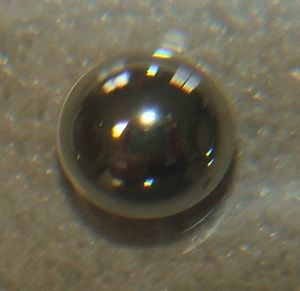I have compiled a list of sources for the elements that are available to the amateur chemist. Mercury will be discussed here.
Mercury is one of the two liquid elements on the periodic table and the only metal that is liquid. Well known for its toxicity and interesting properties, mercury is a fascinating element to experiment with. Mercury itself is a mobile (easily flows), silvery gray, and dense metal. Under certain conditions, it may form a skin of orange mercury(II) oxide, although my mercury has never done this. Mercury forms alloys with many elements known as amalgams. Mercury is found in the ore cinnabar, which consists of red mercury(II) sulfide. When it is roasted in air, it forms mercury vapor, which can be condensed to form pure metallic mercury. Sometimes cinnabar is oxidized by air, forming droplets of native mercury, which are the only liquid mineral. Mercury is a rather inert metal, but it dissolves in oxidizing acids to produce various colorless mercury salts. Mercury(II) chloride, the most common source of mercury ions, is a colorless, highly toxic, and water-soluble solid. Most insoluble mercury compounds are brightly colored.
In element form: Old tilt switches contain beads of mercury metal. These can be found in old thermometers, barometers, and blood pressure sensors. Mercury vapor bulbs have mercury vapor and sometimes mercury metal in them. Fever thermometers used to contain mercury metal. Dental amalgams contain 50% mercury. Fluorescent bulbs contain tiny amounts (5 milligrams or so) of mercury vapor. High pressure sodium bulbs have sodium amalgam in them.
In compound form: Cinnabar is made of mercury sulfide.



